Solasta: Crown of the Magister — Closer to the tabletop RPG experience than ever before
The first game from Tactical Adventures, Solasta: Crown of the Magister is a tactical RPG using a faithful translation of Dungeons and Dragons 5th edition. Players create a party of adventurers and delve into ancient ruins and dungeons, searching for lost artifacts and legendary threats whilst using the environment to their benefit in tactical combat.
You wait years for a new D&D CRPG to come along and, wouldn’t you know it, two go into Early Access at practically the same time. While Larian’s Baldur’s Gate 3 has been getting the fanfare, Tactical Adventures have been quietly running a successful Kickstarter campaign for their first game, Solasta: Crown of the Magister. Where Larian has tried to adapt the D&D ruleset into a CRPG system, Tactical Adventures have taken a much more faithful approach, with a few notable exceptions, in an attempt to recreate as much of the tabletop experience in a game as they could.
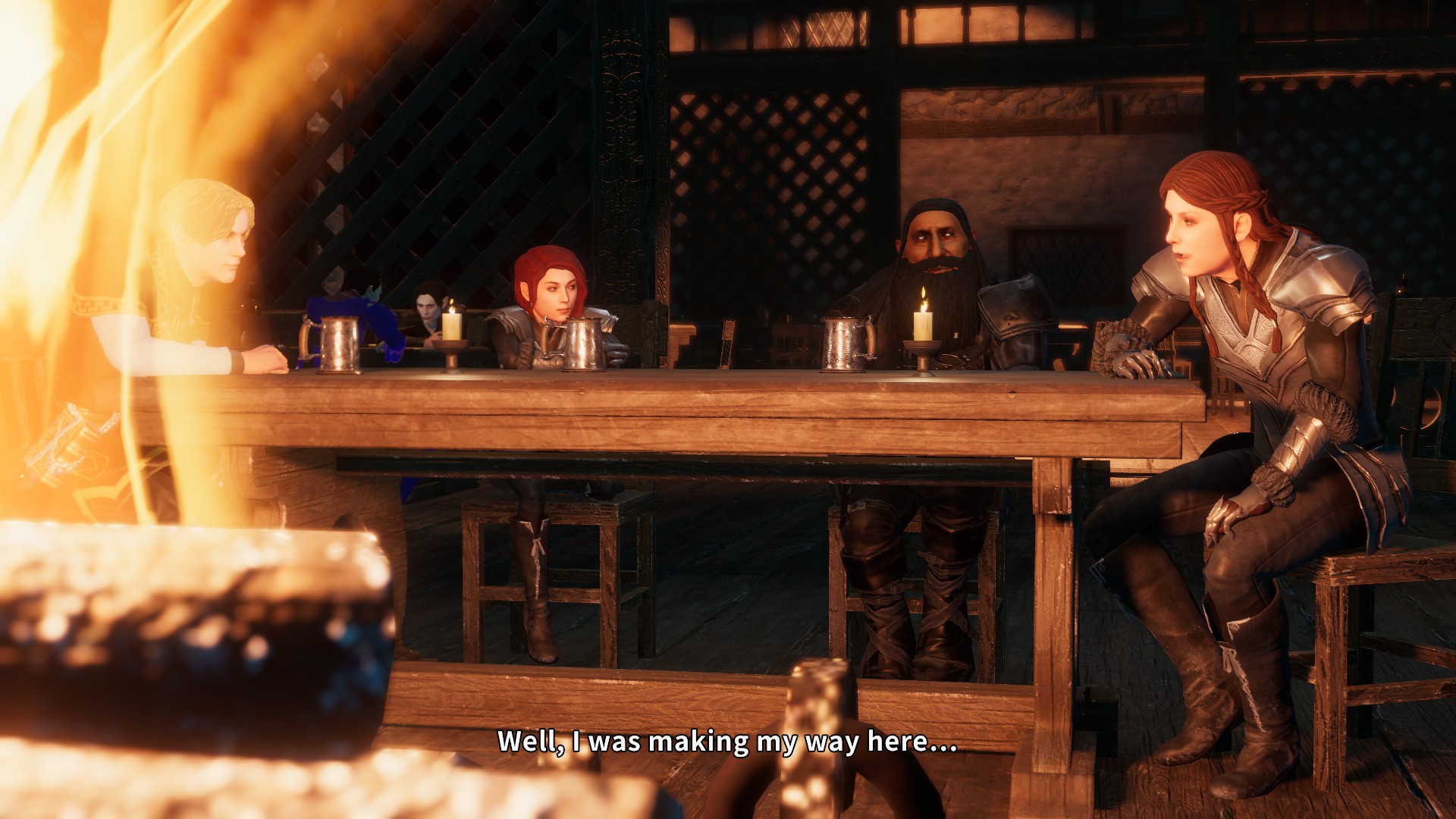
Solasta begins with character creation. The game only has the D&D SRD licence (a stripped-down version of the rules) and so some racial and class options that D&D vets might be used to are absent. There is still plenty of choice though, with four races (and sub-races) and six classes (fighter, cleric, rogue, wizard, ranger and paladin). Character creation is very faithful to D&D, following exactly the same steps. This involves some steps that at this stage (remember, Solasta is only in early access) don’t seem to do anything, such as picking languages. The process of creating a character in tabletop D&D, though, is about more than making mechanical choices. The game encourages you to think of character and backstory first and Solasta does the same. Not all choices have to have a mechanical purpose.
Probably the most interesting thing about character creation in Solasta is the way that it dynamically creates a personality for your character. Depending on choices you make in class, background, alignment and other areas, the game will assign your character different personality tags, with some being stronger than others based on your choices. My dwarf rogue Gargan, for example, was concerned with self-preservation and caution, with a cynical streak of humour. My halfling ranger, Melly, however, was altruistic but sured a level of pragmatism with Gargan. The most impressive thing about this system is it actually affects how your characters talk in the game. They will have different dialogue depending on their personality. Gargan was quite the sweary-Mary whereas Ilaster, my noble elf mage, was very stiff and formal. None of these personality options make choices for you in the game, it’s still entirely up to the player what happens, but they do give a different flavour to proceedings.

All of this has the effect of making your party of four characters feel both alive and deeper than the blank slates they would be in most games, and gives you a huge control over your playstyle in combat. You can make a party of close combat machines; with a mix of fighters, clerics and paladins. Alternatively, you can take the subtle option and use rogues and rangers to move in the shadows and strike from afar. With the exception of Divinity: Original Sin 2, I haven’t really experienced this level of combination of playstyle control and character in RPGs before.
Character creation isn’t perfect, however. The visuals are one area Solasta is a little disappointing. There are a few options of face, build, hair, voice and such like, but not too many and many of the options are, not to put too fine a point on it, ugly. Considering Tactical Adventures are, presumably, working with a fairly low budget here it is to be expected that some parts of the game might lack polish or not be of the highest quality but, given the player will be with these characters for a lengthy time, it would be nice if the options and the artistic quality of the character models were to increase. The good news here is that, just a few days ago, in a patch release, Tactical Adventures included some improvements to the character faces so this work will hopefully continue up to release.
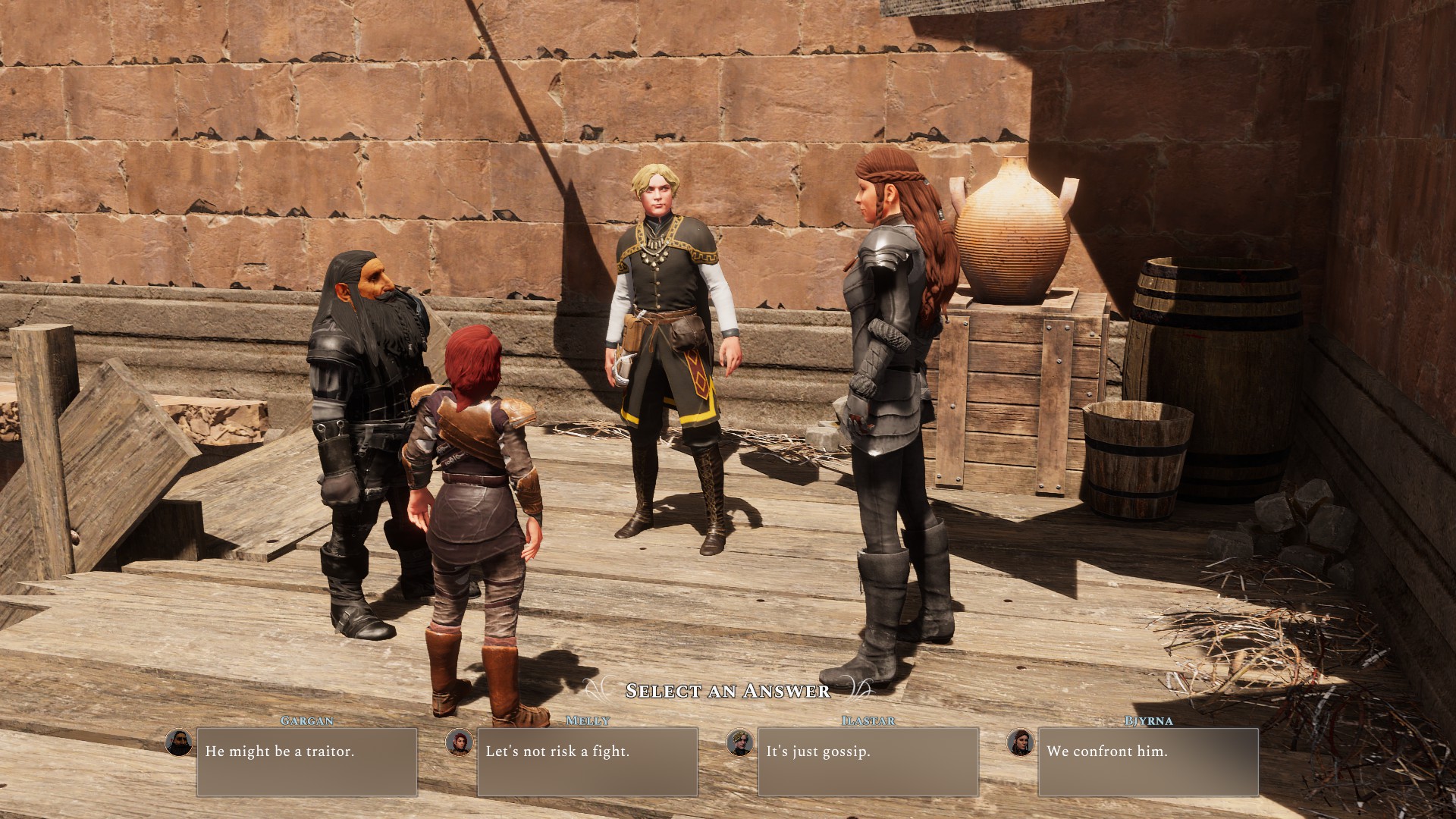
Once the rewarding but lengthy process of character creation is over, you are thrust into the story in the only way a true D&D campaign can begin; with your character meeting in an inn and waiting for a mysterious contact to show up with a quest. As the characters wait they drink beer and have banter as each, in turn, spins a story of their fraught journeys to the inn. These little single-character vignettes serve as tutorials to the game’s different combat, stealth, exploration and lighting mechanics. They are also great little introductions to the characters and you can see already how their different personalities are reflected as they chat, joke and complain. The only thing that lets this system down a little, like with the character creation, is a lack of quality in places. The voice acting is very variable and some of the line delivery is very variable. To be fair to the actors, I imagine that some of this is due to the different circumstances in which the lines can occur. With different characters having different takes on the same situations it would be very difficult to create a system of voice delivery that flowed seamlessly in every situation.
After a short trawl around the starting town, the party is quickly into their first quest. This involves travelling across the world map to investigate an outpost that has gone quiet. Something that players will quickly pick up on in Solasta is that it does not skimp on any aspect of the D&D ruleset. I mean, they did pay for the thing so may as well get full value. Journeying from one place to another is its own minigame. Rations must be managed and travelling at speed must be balanced with caution. Move fast and you will reduce time spent and rations consumed but are likely to be surprised by hostile encounters and won’t have time to forage for ingredients and food on the way. Move slowly and you will be less likely to be ambushed, and can supplement your rations with hunted food, but it may not be enough to get to your destination without running out.
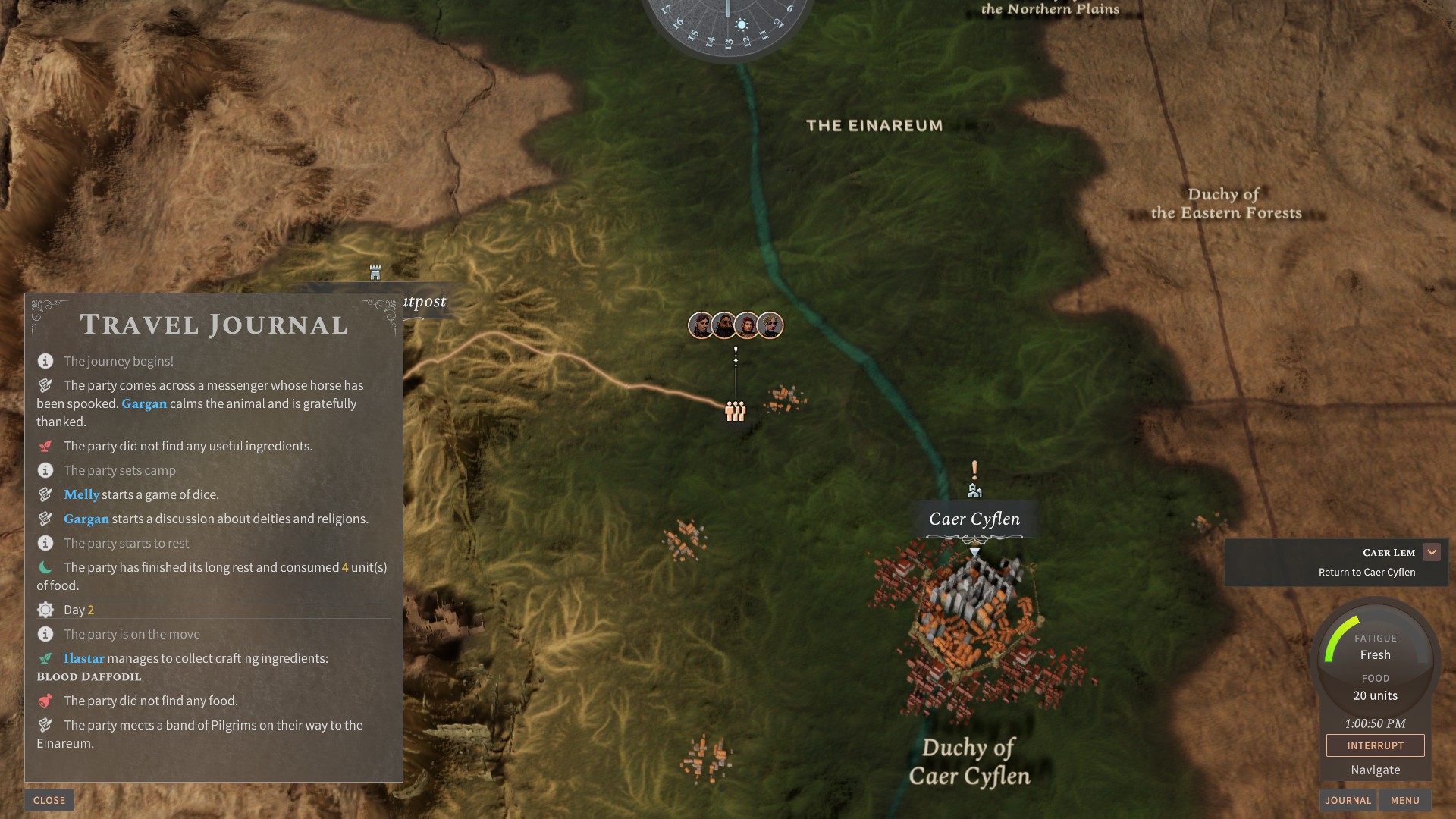
One thing that you should be picking up by now is that Solasta likes to take any opportunity to add a little charm and character to your party. Travelling is no exception. As you move there will be a log of things that happen to your little guys in the bottom left. This log mentions mechanically useful things such as your ranger catching some rabbits or your wizard harvesting spell ingredients. More than this though it gives little one line descriptions of things that happen to your party or things they spot. This might be an ancient tree they discover, a caravan of merchants they chat with or one of dozens of other options. It will also list what your characters talk to each other about when they camp and how they busy themselves; maybe having a philosophical debate or playing dice. None of this has the slightest effect on the game but I absolutely love it. It goes a long way towards adding some depth to proceedings and creating that tabletop feel.
Sooner or later, you’re going to end up in a fight; whether it’s ambush on a road or exploring the locations you’re travelling to when you arrive. Combat in Solasta is pure D&D; every participant makes an initiative roll to see the order they will act in. On your turn, your characters can move up to their speed and perform one action and one bonus action. What you can do with these actions is entirely dictated by your character. My cleric, for example, could cast a spell with her bonus action that would make her next attack do extra damage and then use her action to carry out that attack. My rogue, by contrast, has the ability to move extra distance or to hide with their bonus action and then use their action to get a sneak attack in.
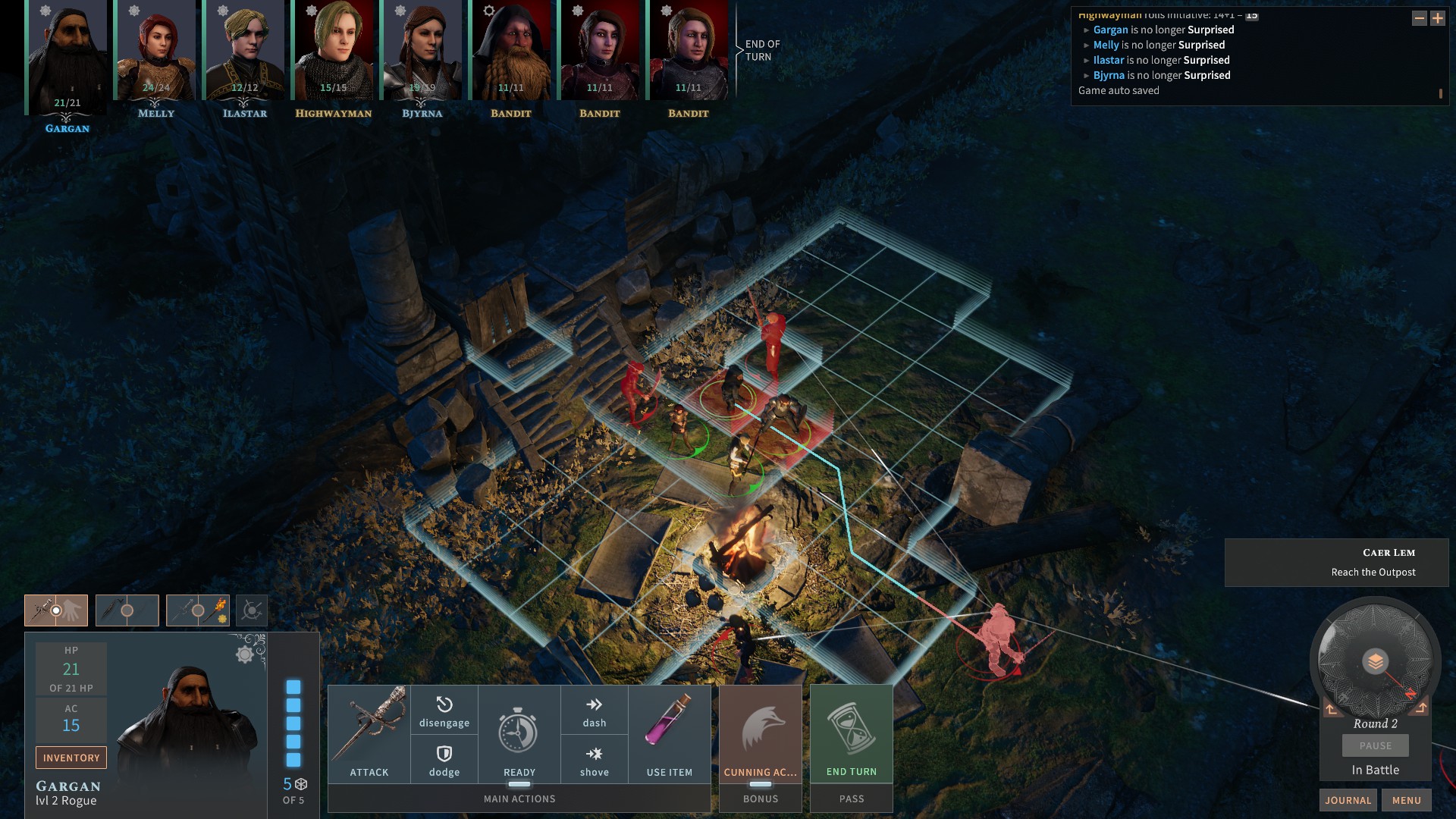
As well as your characters’ abilities, players must get used to the environment too. Light is a big factor in battle. Your party has various light sources available to them and torches in the area can be lit. The choice between whether to illuminate your area or to risk attacking poorly lit enemies is a constant push and pull. The light system is one area that Solasta does diverge from pure D&D rules and the system is interesting, but imperfect. Tactical Adventures continue to work on the implementation and this is one area I expect to see a lot of change before full release. The verticality of the battlefield is another flaky area at the moment. There are many options to get up above your opponent to gain the advantage in the game but, well, it actually doesn’t give you an advantage at the moment. This, I presume, is a miss in the engine and will no doubt be corrected. Once these issues are ironed out in Solasta it will make the combat an interesting, tactical exercise, although they are a touch on the easy side at the moment.
The biggest problem with Solasta at the moment is probably how easy it is (or isn’t) to get to grips with all the systems in play. The D&D rulebook is hundreds of pages long and there are systems atop systems in place in it, most of which are present in Solasta. Some things are not explained that well, or the effect that they are having on the game is hard to see. Even as someone who has played tabletop D&D a fair amount, I found myself struggling in places to understand exactly why something was or wasn’t happening. One easy way to help with this would be for Tactical Adventures to add more depth to the dice roller. Baldur’s Gate 3 does a wonderful thing with its log where hovering over any dice roll will show you all the component parts that contributed to it. It’s a great way to understand what is currently impacting your character and what effect different situations have. Solasta’s log is a little lacking in this area and hopefully it’s something that will see improvement.
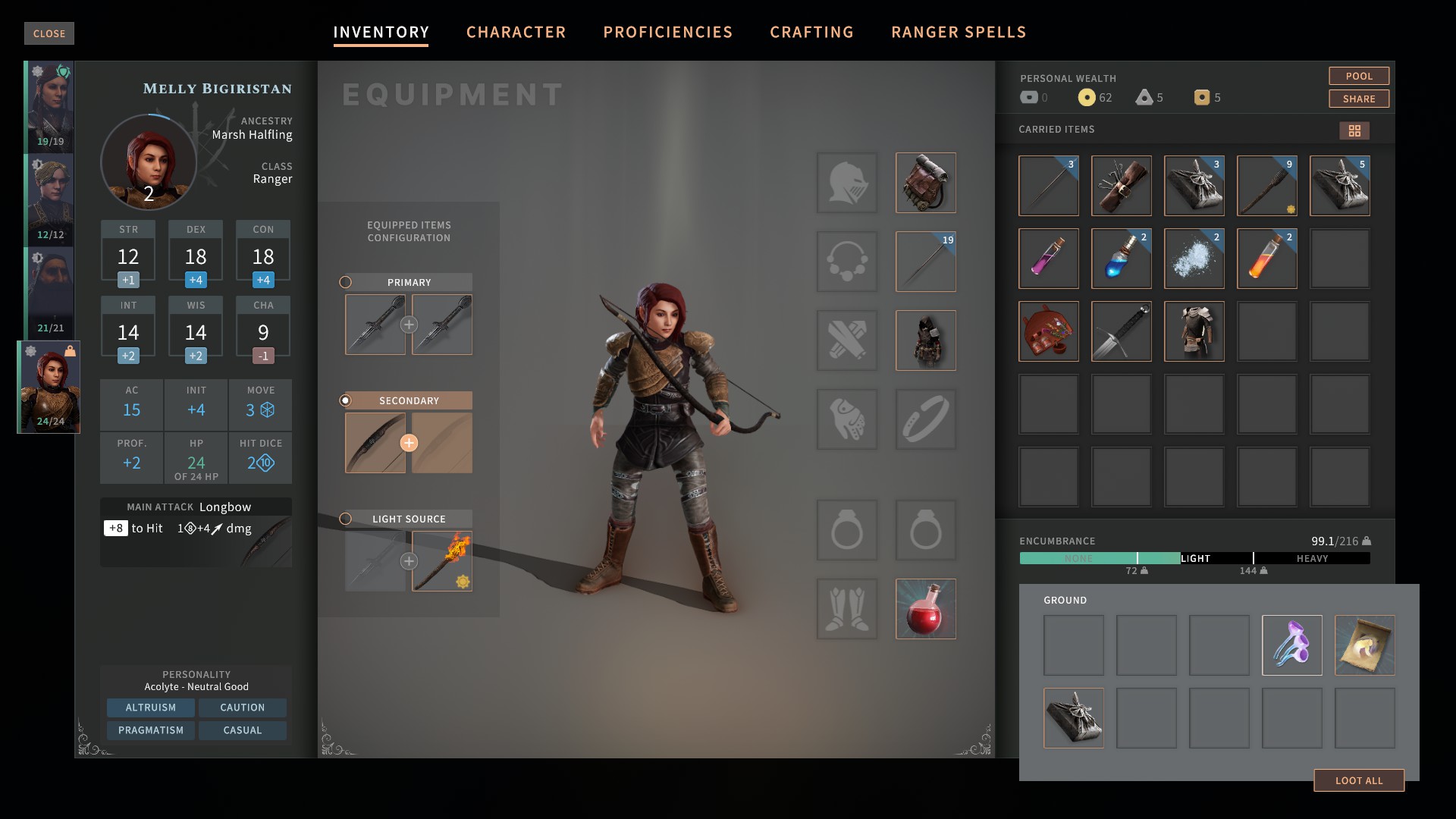
Overall I had an absolute blast with the early access of Solasta. There is about 12-15 hours of content in it at the moment and the game shows a huge amount of promise. It is trying, and mostly succeeding, at doing some truly unique things in the CRPG space. If you are a fan of D&D, or of tabletop RPGs in general, then I definitely recommend getting in on some of this action. If that world is unfamiliar to you then you might find yourself confused and frustrated with the system, both for its (at times) excessive depth and the opacity of some of its systems but I would still recommend trying it out. As Solasta gets closer to full launch it should only get better and better and I believe there is a very high chance that the full game will be a special and very different kind of CRPG system. Also, spoilers, it’s better than Baldur’s Gate 3 at the moment; so there’s also that…
Solasta: Crown of the Magister is in early access and is available now on Steam.
Comments are closed.